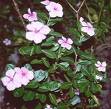My dad has been promising to take me to the Mughal Gardens in Rashtrapati Bhavan every year, for years, but we finally managed to go only this year. I had visited the place as part of an excursion in the third grade once before, and have memories of it being really beautiful - especially the round garden. On this visit I was truly able to recognize the value of the work put in by the malis (gardeners) and landscapers to make the President's Garden look like a paradise on earth (guarded by angels dressed as cops...ha ha ha).
The Mughal Gardens in Rashtrapati Bhavan in New Delhi consist of seven gardens. They are the Herbal Garden, Bonsai Garden, Musical Garden, Main Mughal Gardens, Rose Garden, Circular Garden and Spiritual Garden.

Citronella Plant
1. Herbal Garden: This is the first garden you enter after passing through security. This garden showcases plants that are used in the manufacture of various products. Some of the plants in this garden were lemon grass and citronella (mosquito repellents), Damask rose (used in perfumes and soap making), aloevera (skin creams), garlic and some other medicinal herbs.

Jade Plant
2. Bonsai Garden: This garden displayed about two hundred bonsai versions of trees, some of them being the Chinese orange, jade plant, banyan tree, bouganvilla, mango tree and tamarind tree. I feel sad for these trees as they are not being allowed to grow to their full size, and are being stuffed in a small pot all their life. Here, I discovered that a plant I call 'round-round' because of its round leaves, is actually named the 'jade plant'.

Giant Chrysanthemums
3. Musical Garden: After coming out of the bonsai garden, we passed a huge musical fountain that danced to the tune of patriotic songs like 'meri desh ki dharti sona ugle' (the earth of my country grows gold). The fountain was surrounded with a charming garden of coloured giant chrysanthemums, dahlias, giant pansies and lots of security. Surprisingly, I noticed a cage about 100 metres away with deer and turkeys.

Flower Wall
4. Main Garden: After climbing a flight of red sandstone steps, we entered the beautiful Mughal Gardens with the imposing Rashtrapati Bhavan as the backdrop. The sky was bright blue, the sun rays reflected of the sparkling fountains and the air was filled with a heavenly fragrance. The garden looked truly magnificent with the wide variety of vibrant flowers blooming in the warm spring sunshine. Some of the flowers included giant chrysantamums, giant marigolds, dogflowers, giant pansies in all colours of the rainbow, red and white lilies, different types of roses, tulips and much more.

Green Rose
Of special interest was the 'Green Rose', which was camouflaged in its bush. People were crowding and craning their necks to see it, making the cops nervous. Another flower called the 'Kiss of Fire', was attracting glances and silly comments. There was also the flower wall, which consisted of a small patchwork of plant beds, which were displayed vertically (see photo above).

Oklahoma Rose
5. Rose Garden: After exiting the main Mughal Gardens, we entered the small rose garden, also known as the Pardha Garden. It is surrounded by high sandstone walls, on which golden begonias and sweet pea were growing. The rose garden consists of around 16 rose beds, on each side of a long path. Some of the varieties of rose growing here were the Louisiana, Christian Dior, Oklahoma, Pasadena, Montezuma, and Summer Snow. Along the path, were hanging baskets of really small multi coloured pansies. I felt really cozy and comfortable in this garden.

Dog Flower (Snapdragon)
6. Circular Garden: The rose garden opened into the circular garden, also known as the Butterfly Garden. It was built like a bowl on several levels, and had a giant fountain bubbling in the centre. Some of the flowers planted here were giant marigolds (gainda), giant chrysanthemums, giant pansies, dogflowers, roses and lilies; in almost every colour imaginable. The borders of the circular garden were planted with sweet pea and dahlias, and had butterflies and honeybees flitting among the lush green leaves. Even the grass on the pathways seemed like silky green cushions. This garden was truly magnificent, and is one of the main reasons I wish I could be the President of India some day.

Mehendi Plant
7. Spiritual Garden: This garden had trees and plants which are of use in daily life, or which are mentioned in ancient Indian religious texts. Some of them were henna (mehendi), amla, shikakai, ritha, tulsi, haldi (tumeric), mirch (red chillies), pudina (mint), methi, dhania, jasmine (motia/mogra), Ashoka tree, Peepal tree, Tamarind tree, Banyan tree, and many more.
Before leaving, I purchased one bag of general compost (35) and half a bag of vermi-compost (Rs.20) for my plants at home. I also bought one Rashtrapati Bhavan bookmark (Rs.5), and a wooden clock souvenir(220). The arrangements at Rashtrapati Bhavan were pretty decent, considering the fact that no entry fee was charged. Bottled drinking water was also free.
I wished I could have taken some photos though...but this was not permitted. I suppose this would be because a massive crowd posing for photos would have damaged the beautiful flowers and landscaping. Have you been to the Mughal Gardens in Rashtrapati Bhavan, New Delhi? Which is most beautiful garden you have seen?














